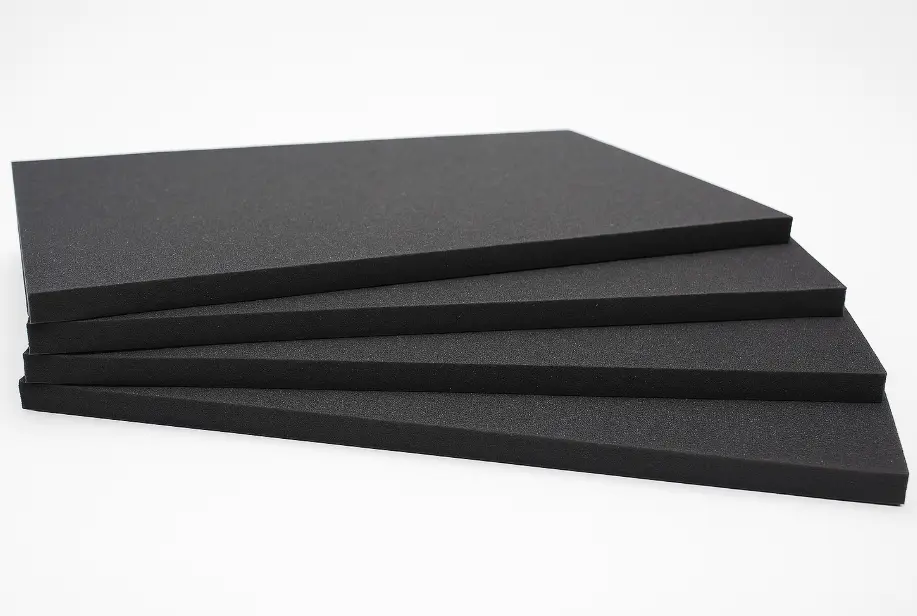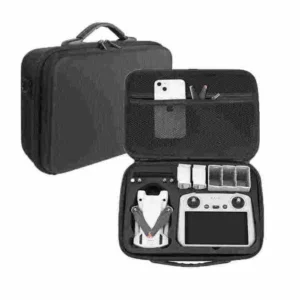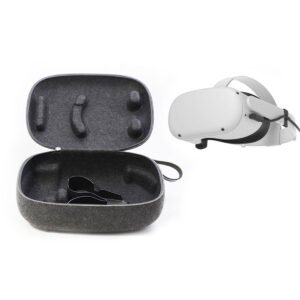Anti-Static EVA Foam: The Ultimate ESD-Safe Packaging Material for Electronics

What is Anti-Static EVA Foam?
Anti-static EVA foam is a specialized foam material engineered to safely dissipate static electricity before it can damage electronics. EVA stands for ethylene-vinyl acetate, a copolymer plastic that produces a resilient closed-cell foam. To make it anti-static, manufacturers blend the EVA resin with special additives or fillers during the foaming process. For example, conductive carbon powder or an anti-static agent is mixed into the EVA, which gives the foam permanent electrostatic dissipative properties. This means the finished foam does not build up static charges; instead it bleeds off charge at a safe rate. The foam is often produced in black or pink colors – black indicating the presence of carbon-based conductive filler in many cases. The result is a durable, lightweight foam that provides both physical cushioning and ESD protection. In short, anti-static EVA foam is EVA packaging foam made ESD-safe by design, ideal for safeguarding sensitive electronics from the dual threats of shock and static.
Key Features of Anti-Static EVA Foam
Anti-static EVA foam inherits many beneficial properties from its EVA base material while adding electrostatic safety. Below are some of its key features and material characteristics:
-
Water Resistance: EVA foam has a closed-cell structure, making it resistant to water and moisture absorption. This water resistance means the foam won’t soak up humidity or liquids, an important feature for packaging in damp conditions or for reusable applications. Sensitive devices remain protected even in high-humidity environments.
-
Corrosion & Chemical Resistance: Anti-static EVA foam is chemically inert and resistant to many corrosive substances. It can withstand exposure to oils, acids, alkalis and organic solvents without degrading. The material doesn’t corrode or leach harmful chemicals over time, and it contains no corrosive anti-static additives (no amine or ammonia outgassing). This stability ensures long-term performance in various industrial environments.
-
Machinability (Easy Fabrication): EVA foam is easy to fabricate and customize. It can be cut, die-cut, CNC-carved, or molded into virtually any shape needed. The foam’s fine, uniform cell structure enables precise cutting with minimal fraying. Manufacturers can readily create custom foam inserts, trays, and pads tailored to specific products. This machinability is a big advantage for tooling and packaging – foam inserts can be perfectly shaped to hold delicate items securely.
-
Shock Absorption & Cushioning: Like standard EVA foam, the anti-static variety offers excellent impact absorption and cushioning performance. Its semi-rigid, rubbery structure dissipates energy from drops or vibrations, protecting sensitive components from mechanical shock. EVA’s resilience and damping characteristics make it ideal for packaging fragile electronics that require both softness and support.
-
Insulation: EVA foam provides good insulation in multiple ways. Thermally, it has low conductivity, so it insulates against heat and temperature fluctuations. This can help shield electronics from extreme temperatures or sudden changes. Additionally, EVA is a polymer and inherently an electrical insulator; in its base form it does not conduct electricity. The anti-static grade is slightly modified to be dissipative (not fully conductive), but it still isolates components from direct electrical contact while bleeding off static.
-
Soundproofing: Thanks to its cellular foam structure, EVA foam also serves as a sound-dampening material. It can absorb and reduce vibrations and noise. In packaging, this means it not only cushions against physical shock but also muffles rattling or vibration of components. In facilities, EVA foam lining can contribute to a quieter operation by absorbing noise from equipment or component handling.
Beyond these, anti-static EVA foam is also known for being wear-resistant and durable (it doesn’t crumble or shed easily). It retains its properties over time, including its ESD performance, which is typically permanent. Unlike temporary anti-static coatings, the anti-static quality of EVA foam is embedded in the material, so it won’t wear off or dissipate due to ambient conditions.
Why are Anti-Static (ESD) Properties So Important?
Electronic components such as integrated circuits (ICs, microchips), printed circuit boards (PCBs), and semiconductor devices are highly sensitive to electrostatic discharge. Even a tiny zap of static—too small for a person to even feel—can destroy or degrade a delicate microelectronic component. This is why using an ESD-safe packaging foam is crucial for electronics. Anti-static EVA foam is designed to prevent static buildup and rapidly dissipate any charges, creating a safer environment for sensitive devices.
In normal packaging or foam, friction can generate static electricity that has nowhere to go until it suddenly discharges (for example, a chip touching a charged foam might suddenly equalize and get a shock). Anti-static EVA foam solves this by having a controlled surface resistivity (often in the range of 10^6–10^9 Ω). This means it conducts electricity just well enough to bleed off static charge slowly, but not so much that it acts like a metal. As a result, the foam will absorb and dissipate static charges that may build up during handling or transport. Any charge is safely neutralized before it can arc into a component.
The importance of this cannot be overstated. Industry studies have shown that ESD damage can cause immediate failures or latent defects that only appear later. Using anti-static packaging foam greatly reduces the risk of such damage. In fact, ESD-safe foam cushions and secures electronic components while also absorbing static and safely draining it away. It’s a dual protection: physical shock protection and electrical charge protection in one. For B2B customers shipping electronics, this means far fewer returns, failures, or warranty issues due to static damage.
Another key point is that high-quality anti-static EVA foam is permanently anti-static. The anti-static performance is not affected by ambient humidity or timeesdgoods.com. (Some older “pink foams” lose effectiveness as additives evaporate, but EVA with permanent conductive filler avoids that.) Because of this, packaging made from anti-static EVA foam remains reliably ESD-safe throughout its life. As long as the foam is intact, your devices are shielded from static buildup. It creates an ESD-safe cocoon around the product – essentially functioning like a soft Faraday cage that dissipates charges continuously. Unsurprisingly, ESD-safe packaging foam like this has become a standard in electronics manufacturing and shipping. Using it is considered a best practice to comply with ESD handling standards and to protect high-value componentsvaldamarkdirect.com.
In short, anti-static EVA foam’s ESD properties are important because they prevent invisible killers (static discharges) from ever reaching your sensitive electronics. The foam safeguards components by neutralizing static electricity, which ensures that delicate devices arrive at customers or move through production unscathed by electrostatic damage.
Applications of Anti-Static EVA Foam
Because of its unique combination of properties, anti-static EVA foam is used in a wide array of applications across the electronics industry and beyond. Any situation requiring both cushioning and ESD protection is a great fit. Below are some common use cases:
PCB and IC Packaging
One of the primary uses of anti-static EVA foam is for packaging printed circuit boards (PCBs) and integrated circuits (ICs). Electronic manufacturers often ship circuit boards or sensitive chips cushioned in anti-static foam inserts or foam-lined boxes. The foam prevents physical damage and creates an ESD-safe environment around the electronicsshunhogroup.com.hk. For example, foam sheets or blocks may be die-cut to hold a circuit board in place inside a container, or IC chips might be pressed into anti-static foam slots. This ensures that from factory to end-user, the components are never exposed to random static discharges. Companies also use EVA foam pads inside static shielding bags or corrugated ESD boxes for additional cushioning of PCBs. By using anti-static EVA foam in packaging, PCB assemblies, computer motherboards, memory modules, and other delicate boards can be shipped safely without fear of static shock or vibration damage.
Circuit Board Storage and Transport
Beyond one-time packaging for shipping, anti-static EVA foam is widely used for storage and internal transport of circuit boards. In electronics assembly plants, you will find ESD-safe foam in the trays, bins, and turnover boxes that carry boards between workstations. In fact, EVA foam inserts often replace hard plastic dividers in PCB storage bins because foam offers better protection and doesn’t generate static on its own. Foam-lined PCB racks or containers hold boards securely in place during transit within a facility or between facilitiesesdgoods.com. The foam’s cushioning prevents scratches or bending of the boards, and its anti-static nature prevents any charge from accumulating as boards slide in or out. Many factories report that swapping out plain plastic tubs for anti-static foam-lined trays greatly reduced ESD incidents and even improved handling (no sharp edges to nick components)esdgoods.com. Circuit boards in storage or transit remain fully protected on all sides by the foam – shielded from jolts and static electricity until they reach their destination.
Electronics Workbench Liners and Trays
Anti-static EVA foam is also employed as a lining material for workbenches, assembly trays, and tool drawers in electronics manufacturing environments. Work surfaces in EPA (ESD protected areas) must be static-dissipative. EVA foam sheets can be cut to line the tops of workbenches or the insides of trays that hold sensitive components, providing a soft, ESD-safe work surface. For instance, an electronics assembly worker might have a tray with EVA foam lining each slot where a partially assembled device or set of chips is placed. This foam lining ensures that the component is cushioned and any static on the worker’s hand or tool is bled off through the foam rather than discharging into the part. Permanent anti-static EVA foam is often used together with ESD-safe bins and boxes in PCB factories to add a layer of ESD protection and cushioningsinkeryfoam.com. The foam can be easily cut to custom-fit the shape of a drawer or tray. Unlike some ESD table mats, EVA foam liners also add impact protection, which is useful if tools or components are dropped onto the bench. In summary, anti-static foam liners on workbenches and trays create a safer assembly environment by combining static control with physical padding.
Tool Case Inserts for Sensitive Devices
Many industries use custom tool cases or instrument cases with foam interiors to protect equipment – and when that equipment includes electronics, anti-static EVA foam is the go-to choice. For example, a field service kit for telecom or medical equipment might have a hard carrying case with precisely cut EVA foam inserts to hold each instrument. By using anti-static EVA for the insert, the case ensures that sensitive devices (like diagnostic tools, sensors, or even laptops and tablets) are not only cushioned against bumps but also safe from static buildup inside the case. Custom case manufacturers frequently employ ESD-safe foam inserts for electronics, since cases designed to protect delicate gear should neutralize static as wellroyalcase.com. The foam insert is usually tailored to the device’s shape, cradling it securely (which also prevents movement that could cause friction and static). Anti-static foam inserts are used in gun cases for electronic sights, in drone cases for the drone and its circuitry, in aerospace and defense equipment cases, and for any portable electronics that need robust protection. By dissipating charges, the foam insert eliminates the risk of static shocks when the device is taken out or put back in. As Royal Case Company notes, these anti-static custom case interiors “safely dissipate static electricity” and prevent harmful ESD events from occurringroyalcase.com. For B2B customers, this means mission-critical electronics or calibration tools will work right out of the case without ESD damage – a small but significant assurance of reliability.
Cleanroom and EMI-Shielded Room Linings
In highly controlled environments like cleanrooms and EMI-sensitive facilities, anti-static EVA foam also finds niche but important uses. Cleanrooms (such as semiconductor fabrication plants or pharmaceutical labs) strive to eliminate dust and static. EVA foam pads or panels with anti-static properties can be used to line surfaces, walls, or floors in certain cleanroom applications, acting as cushioned, ESD-safe bumpers. The foam’s anti-static nature helps prevent dust attraction (since static charges can attract particles) and of course protects any sensitive apparatus from ESD. Colored anti-static EVA foams have even been used in cleanroom assembly processes for electronics, serving both functional and organizational purposesesdgoods.com.
Meanwhile, some EMI-shielded rooms or enclosures (used for testing electronic equipment or housing sensitive communications gear) utilize conductive foam materials as part of their shielding strategy. Conductive grades of EVA foam not only dissipate static but can also help absorb or block electromagnetic interference. In fact, conductive EVA foam is noted to serve as an effective EMI shield by attenuating electromagnetic waves in certain applicationsshunhogroup.com.hk. This means foam panels can line an EMI test chamber to both cushion equipment and reduce stray RF interference. Similarly, anechoic chambers or EMI cabinets might use anti-static or conductive foam pieces at joints or openings to maintain the RF shield continuity while providing a sealing or cushioning function. In summary, anti-static EVA foam can be used in cleanrooms to maintain a static-free environment and in EMI-shielded setups to assist in blocking interference, all while offering the mechanical benefits of foam.
Custom Anti-Static EVA Foam Solutions – Your Next Step
Anti-static EVA foam clearly offers a powerful combination of protection for electronics – guarding against both physical shocks and static electricity. Its water-resistant, chemical-resistant and easily fabricated nature make it adaptable to many use cases, from factory floors to field equipment cases. If your business deals with sensitive electronics, using ESD-safe packaging foam like anti-static EVA inserts is a smart investment in quality and reliability. It can mean the difference between a flawless delivery and a costly damage claim. The good news is that this material is highly customizable. You can get custom-cut EVA inserts for electronics of any shape or size, tailored to your product dimensions and performance needs.
As a manufacturing and packaging company, we offer expert guidance in designing the right anti-static EVA foam solution for your application. Whether you need foam inserts for PCB shipping boxes, specialized tool-case padding, or bulk foam sheets for an assembly line, we can fabricate the ideal foam product. These ESD foam inserts allow you to ship electronics without worry of any static damage or impactesdgoods.com. With our in-house die-cutting and CNC capabilities, we ensure each insert or liner fits perfectly and meets the required ESD specifications.
Ready to protect your sensitive devices with confidence? Reach out to our team today to discuss custom anti-static EVA foam solutions for your business. We’ll help you engineer a packaging or cushioning solution that keeps your electronics safe from shocks and static every step of the way. Secure your products – and your reputation – by using the right foam for the job. Contact us now for a consultation and take the first step toward safer, smarter electronic packaging.
Ready to upgrade your packaging with a professional EVA tool case?
Contact our team today – we’ll design it for your tools, your brand, your market.





